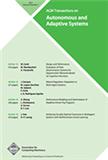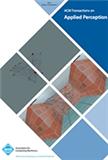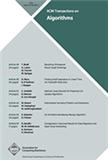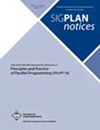ACS Sensors
无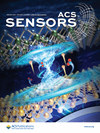
- 杂志名称:ACS传感器
- 简称:ACS SENSORS
- 期刊ISSN:2379-3694
- 大类研究方向:工程技术
- 影响因子:6.944
- 数据库类型:无
- 是否OA:
- 出版地:
- 年文章数:239
- 小类研究方向:工程技术-化学综合
- 审稿速度:
- 平均录用比例:
官方网站:
投稿网址:
ACS Sensors
英文简介ACS Sensors is a peer-reviewed research journal that is devoted to the dissemination of new and original knowledge on all aspects of sensor science that selectively sense chemical or biological species or processes. Articles may address conceptual advances in sensing that are applicable to many types of analytes or application papers which report on the use of an existing sensing concept in a new way or for a new analyte. Application papers should demonstrate the use of the sensor in complex samples, show it is fit-for-purpose, and exhibit a correlation of the sensor’s performance with an existing analytical method. Papers may focus on sensor development for commercialization or developing sensors that are used to provide new scientific knowledge. Articles may be entirely theoretical with regard to sensing, or they may report experimental results. The types of sensors the journal covers include:BiosensorsChemical sensorsGas sensorsIntracellular sensorsSingle molecule sensorsCell chipsArraysMicrofluidic devicesPrimary research papers include Letters and Articles. Note that the maximum length of Letters is four journal pages and Articles are eight. In addition, the journal publishes Reviews, Perspectives, Sensor Issues and Introducing Our Authors. Perspectives should report the authors’ opinion on important new directions in sensing and discuss the nature of the opportunities perceived. Reviews can cover conceptual advances in sensing, review a class of sensor or analyte, or can be more of a tutorial that addresses a specific challenge in sensing and approaches to overcoming it. Sensor Issues will guide the community and new entrants to sensors on where the opportunities and challenges are by highlighting specific sensing issues. Introducing our Authors will feature two authors per issue discussing their scientific and non-scientific accomplishments. See the Author Guidelines for more information on the journal, the manuscript types, and how to estimate paper length.
ACS Sensors
中文简介ACS传感器是一个同行评审的研究杂志,致力于传播传感器科学的所有方面的新的和原始的知识,选择性地感知化学或生物物种或过程。文章可以论述传感方面的概念性进展,这些进展适用于许多类型的分析物或应用论文,这些论文报告了以新方式或新分析物使用现有传感概念的情况。应用文件应说明传感器在复杂样品中的应用,证明其适用性,并表明传感器性能与现有分析方法的相关性。论文可能侧重于传感器的商业化开发,或开发用于提供新科学知识的传感器。文章可能完全是关于传感的理论,或者他们可能报告实验结果。期刊覆盖的传感器类型包括:生物传感器化学传感器气体传感器细胞内传感器单分子传感器细胞芯片数组微流体装置主要研究论文包括信件和文章。请注意,信件的最大长度是四页日记,文章是八页。此外,该杂志还发表评论、观点、传感器问题和介绍作者。观点应该报告作者对感知的重要新方向的观点,并讨论所感知的机会的性质。审查可以涵盖传感的概念性进展,审查一类传感器或分析物,或者可以更多地作为一个教程,解决传感的具体挑战和克服它的方法。传感器问题将通过突出特定的传感问题,引导社区和新进入者了解传感器的机遇和挑战所在。在介绍我们的作者时,每个问题将有两位作者讨论他们的科学和非科学成就。有关期刊、手稿类型以及如何估计纸张长度的更多信息,请参阅作者指南。
ACS Sensors
中科院分区| 大类学科 | 分区 | 小类学科 | 分区 | Top期刊 | 综述期刊 |
| 化学 | 1区 | CHEMISTRY, ANALYTICAL 分析化学 CHEMISTRY, MULTIDISCIPLINARY 化学综合 NANOSCIENCE & NANOTECHNOLOGY 纳米科技 | 1区 2区 2区 | 是 | 否 |
ACS Sensors
JCR分区| JCR分区等级 | JCR所属学科 | 分区 | 影响因子 |
| Q1 | CHEMISTRY, MULTIDISCIPLINARY | Q1 | 9.618 |
| NANOSCIENCE & NANOTECHNOLOGY | Q1 | ||
| CHEMISTRY, ANALYTICAL | Q1 |
ACS Sensors
中科院JCR分区历年趋势图ACS Sensors
影响因子精选同类领域期刊,热门推荐轻松get~
-
- ACM Transactions on Autonomous and Adaptive Systems
- 期刊ISSN:1556-4665
- 大类研究方向:工程技术
- 影响因子:
- 数据库类型:SCIE
- 咨询投稿
-
- ACM Transactions on Architecture and Code Optimization
- 期刊ISSN:1544-3566
- 大类研究方向:工程技术
- 影响因子:1.444
- 数据库类型:SCIE
- 咨询投稿
-
- ACM Transactions on Applied Perception
- 期刊ISSN:1544-3558
- 大类研究方向:工程技术
- 影响因子:
- 数据库类型:SCIE
- 咨询投稿
-
- ACM Transactions on Algorithms
- 期刊ISSN:1549-6325
- 大类研究方向:工程技术
- 影响因子:
- 数据库类型:SCIE
- 咨询投稿
-
- ACM SIGPLAN NOTICES
- 期刊ISSN:0362-1340
- 大类研究方向:工程技术
- 影响因子:
- 数据库类型:无
- 咨询投稿
-
- ACM Journal on Emerging Technologies in Computing Systems
- 期刊ISSN:1550-4832
- 大类研究方向:工程技术
- 影响因子:2.013
- 数据库类型:SCIE
- 咨询投稿
精选常见问题,答疑解惑轻松get~
- 三篇ssci论文怎么同时投出去
- 中文核心和sci哪个影响力更大
- 中科院一区和JCR一区期刊占比区别
- 发ssci如何快速找合适的期刊
- 资源保护方面论文投sci指导
- 外贸行业论文发ssci周期长吗
- 国外的sci投到录用一般多久
- ssci期刊国内认可度
- 核能应用论文翻译英文发sci容易的方法
- 人口老龄化研究论文符合ssci领域吗
- sci开源和不开源分别是什么意思?有什么影响?
- ssci发表是高水平学术论文吗
- 生态修复主题英文论文会收录哪些数据库
- 哲学专业论文发英文期刊
- 中科院sci四个区的划分
- ssci期刊和sci期刊的区别
- ESCI和SCIE要分清
- ssci送审论文多久出结果
- ssci论文二作有用吗
- 水土保持类英文期刊好选吗
- ssci期刊论文一定会检索吗
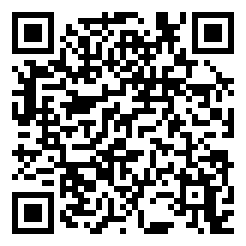 投稿咨询
投稿咨询

